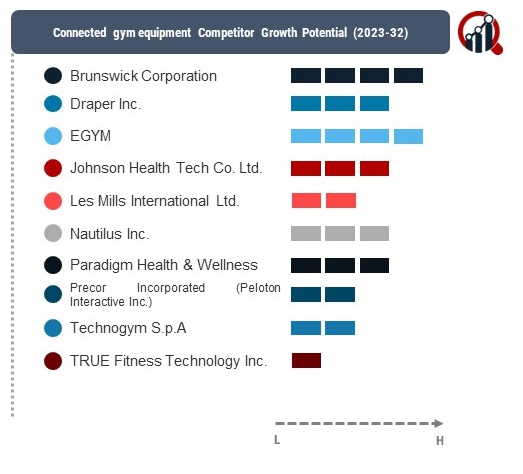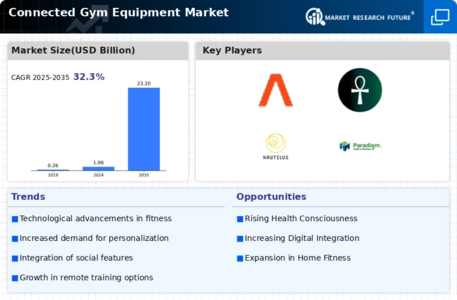Top Industry Leaders in the Connected Gym Equipment Market
 The competitive landscape of connected gym equipment has been rapidly evolving, driven by advancements in technology and a growing emphasis on fitness and wellness. Key players in this dynamic industry are leading the charge with innovative products and strategies that cater to the increasingly tech-savvy and health-conscious consumer base. Brunswick Corporation, Core Health & Fitness LLC, Draper Inc., EGYM, Johnson Health Tech Co. Ltd., Les Mills International Ltd., Nautilus Inc., Paradigm Health & Wellness, Precor Incorporated (Peloton Interactive Inc.), Technogym S.p.A and TRUE Fitness Technology Inc.These industry leaders have strategically positioned themselves by creating a seamless blend of hardware, software, and content. Peloton, for example, revolutionized the fitness industry with its connected stationary bikes and live-streamed virtual classes, fostering a sense of community among its users. Technogym, on the other hand, has focused on integrating cutting-edge technology into its equipment while providing users with personalized training programs through its mywellness platform. MYXfitness and NordicTrack have gained attention by offering a variety of connected fitness equipment that caters to different workout preferences, ensuring a comprehensive and engaging fitness experience.Strategies adopted by key players often revolve around creating a robust ecosystem that extends beyond the hardware. Subscription-based models, offering access to a library of on-demand and live-streamed classes, have become a cornerstone of success. These companies frequently invest in content creation, collaborating with fitness instructors and experts to deliver engaging and effective workouts. Additionally, partnerships with popular fitness apps, health platforms, and wearable devices contribute to a holistic approach, allowing users to seamlessly track and integrate their fitness data.Market share analysis in the connected gym equipment segment involves evaluating several factors. The quality and features of the hardware, the breadth and relevance of the content library, pricing strategies, and customer satisfaction play pivotal roles. The ability to continually innovate and adapt to emerging trends, such as augmented reality and virtual reality integration, is also a key determinant of market share. Moreover, global distribution networks and effective marketing campaigns contribute to brand visibility and customer acquisition.In the ever-expanding landscape of connected gym equipment, new and emerging companies are making strides by focusing on niche markets, unique value propositions, and technological innovations. Companies like Tonal, known for its smart strength training system, and Mirror, offering interactive fitness classes through a reflective display, have carved out their spaces in the market. These companies often leverage compact designs and minimalistic aesthetics, appealing to users seeking both functionality and aesthetics in their home workout spaces.Industry news in the connected gym equipment sector reflects a continuous stream of innovations and partnerships. Advancements in artificial intelligence, virtual reality, and biometric tracking are reshaping the future of fitness technology. Companies are increasingly exploring ways to enhance the user experience through gamification, social features, and real-time performance metrics. Additionally, mergers and acquisitions are prevalent as established players seek to expand their product portfolios and consolidate their positions in the market.Current investment trends in the connected gym equipment industry underscore the sector's growth potential. Venture capital funding and strategic investments are flowing into companies that demonstrate technological prowess, market disruption potential, and a strong user base. Start-ups focusing on personalized fitness experiences, artificial intelligence-driven coaching, and at-home wellness solutions are particularly attractive to investors. Established players are also investing in research and development to stay ahead of the competition, with an emphasis on creating innovative and user-friendly connected fitness solutions.The overall competitive scenario in the connected gym equipment market is characterized by fierce rivalry and a race to capture the expanding market share. Consumer preferences are evolving, with an increasing demand for immersive and interactive fitness experiences at home. The COVID-19 pandemic has accelerated the adoption of connected fitness solutions, as more individuals seek convenient and effective ways to stay fit without leaving their homes. In this environment, companies that can offer a seamless integration of hardware, software, and content while staying ahead of technological trends are well-positioned for success.
The competitive landscape of connected gym equipment has been rapidly evolving, driven by advancements in technology and a growing emphasis on fitness and wellness. Key players in this dynamic industry are leading the charge with innovative products and strategies that cater to the increasingly tech-savvy and health-conscious consumer base. Brunswick Corporation, Core Health & Fitness LLC, Draper Inc., EGYM, Johnson Health Tech Co. Ltd., Les Mills International Ltd., Nautilus Inc., Paradigm Health & Wellness, Precor Incorporated (Peloton Interactive Inc.), Technogym S.p.A and TRUE Fitness Technology Inc.These industry leaders have strategically positioned themselves by creating a seamless blend of hardware, software, and content. Peloton, for example, revolutionized the fitness industry with its connected stationary bikes and live-streamed virtual classes, fostering a sense of community among its users. Technogym, on the other hand, has focused on integrating cutting-edge technology into its equipment while providing users with personalized training programs through its mywellness platform. MYXfitness and NordicTrack have gained attention by offering a variety of connected fitness equipment that caters to different workout preferences, ensuring a comprehensive and engaging fitness experience.Strategies adopted by key players often revolve around creating a robust ecosystem that extends beyond the hardware. Subscription-based models, offering access to a library of on-demand and live-streamed classes, have become a cornerstone of success. These companies frequently invest in content creation, collaborating with fitness instructors and experts to deliver engaging and effective workouts. Additionally, partnerships with popular fitness apps, health platforms, and wearable devices contribute to a holistic approach, allowing users to seamlessly track and integrate their fitness data.Market share analysis in the connected gym equipment segment involves evaluating several factors. The quality and features of the hardware, the breadth and relevance of the content library, pricing strategies, and customer satisfaction play pivotal roles. The ability to continually innovate and adapt to emerging trends, such as augmented reality and virtual reality integration, is also a key determinant of market share. Moreover, global distribution networks and effective marketing campaigns contribute to brand visibility and customer acquisition.In the ever-expanding landscape of connected gym equipment, new and emerging companies are making strides by focusing on niche markets, unique value propositions, and technological innovations. Companies like Tonal, known for its smart strength training system, and Mirror, offering interactive fitness classes through a reflective display, have carved out their spaces in the market. These companies often leverage compact designs and minimalistic aesthetics, appealing to users seeking both functionality and aesthetics in their home workout spaces.Industry news in the connected gym equipment sector reflects a continuous stream of innovations and partnerships. Advancements in artificial intelligence, virtual reality, and biometric tracking are reshaping the future of fitness technology. Companies are increasingly exploring ways to enhance the user experience through gamification, social features, and real-time performance metrics. Additionally, mergers and acquisitions are prevalent as established players seek to expand their product portfolios and consolidate their positions in the market.Current investment trends in the connected gym equipment industry underscore the sector's growth potential. Venture capital funding and strategic investments are flowing into companies that demonstrate technological prowess, market disruption potential, and a strong user base. Start-ups focusing on personalized fitness experiences, artificial intelligence-driven coaching, and at-home wellness solutions are particularly attractive to investors. Established players are also investing in research and development to stay ahead of the competition, with an emphasis on creating innovative and user-friendly connected fitness solutions.The overall competitive scenario in the connected gym equipment market is characterized by fierce rivalry and a race to capture the expanding market share. Consumer preferences are evolving, with an increasing demand for immersive and interactive fitness experiences at home. The COVID-19 pandemic has accelerated the adoption of connected fitness solutions, as more individuals seek convenient and effective ways to stay fit without leaving their homes. In this environment, companies that can offer a seamless integration of hardware, software, and content while staying ahead of technological trends are well-positioned for success.
Key Companies in the Connected Gym Equipment market include
- Brunswick Corporation
- Core Health & Fitness LLC
- Draper Inc.
- EGYM
- Johnson Health Tech Co. Ltd.
- Les Mills International Ltd.
- Nautilus Inc.
- Paradigm Health & Wellness
- Precor Incorporated (Peloton Interactive Inc.)
- Technogym S.p.A
- TRUE Fitness Technology Inc.










